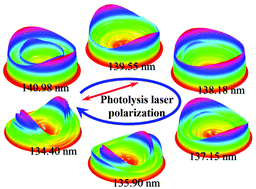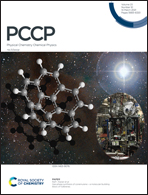Vacuum ultraviolet photodissociation dynamics of OCS + hv → CO(1Σ+) + S(1S0) via the E and F Rydberg states
Abstract
The state-resolved photodissociation of the CO(1Σ+) + S(1S0) photoproduct channel, formed by vacuum ultraviolet photoexcitation of OCS to a progression of the symmetric stretching vibration (ν1′) in the E and F states, has been investigated by using the time-sliced velocity map ion imaging technique. The total kinetic energy release spectra and the vibrational state specific anisotropy parameters (β) were obtained based on the raw images of S(1S0) photoproducts detected in the wavelength ranges of 134.40–140.98 nm, respectively. Except for vibrational band origins, the CO(1Σ+) photoproducts are found to have more significant populations at highly vibrationally excited states as the symmetric stretching vibrational excitation of the E and F states increases. Furthermore, the vibrational-state specific β values for the CO(1Σ+) + S(1S0) channel via the E and F states both show a sudden change from negative to positive in the vicinity of moderately vibronic levels of the E and F states. This anomalous phenomenon suggests that multiple excited states with different symmetries are involved in the photoexcitation process at relatively short photolysis wavelengths due to the strong vibronic couplings existing in the higher vibronic levels of the E and F states, and the formation of CO(1Σ+) + S(1S0) photoproducts may proceed by different nonadiabatic interactions from the prepared excited states to the lower dissociative state 1Σ+, with strong dependence of the initially symmetric stretching excitation in the Rydberg-type transitions.

- This article is part of the themed collection: 2021 PCCP HOT Articles


 Please wait while we load your content...
Please wait while we load your content...